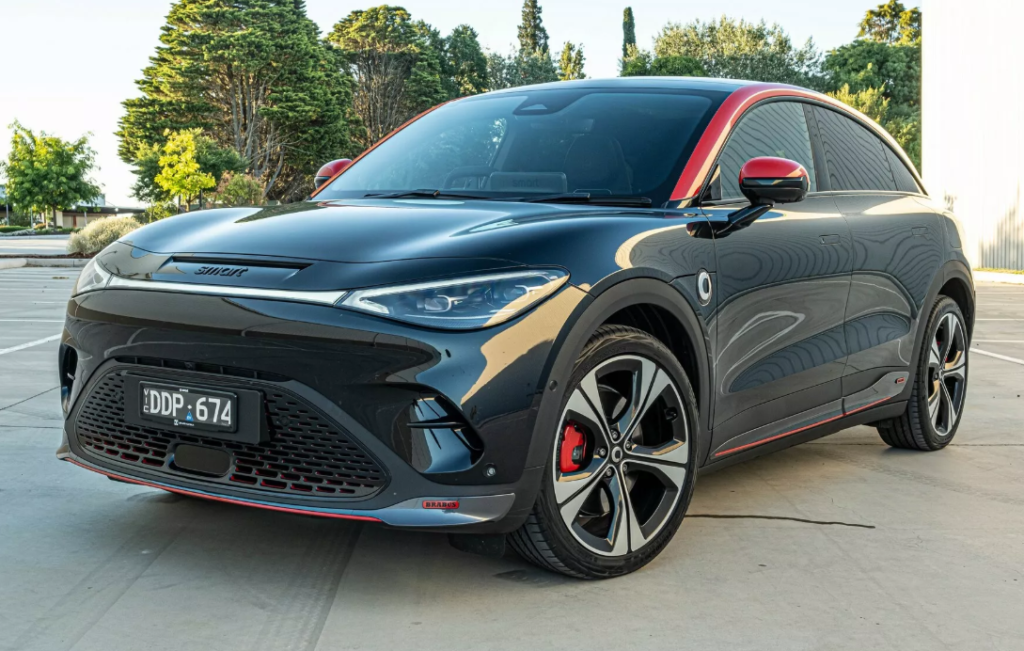Smart #3 Brabus Review : A Stylish, High-Performance EV Alternative

Smart, a brand renowned for its premium tuning expertise through Brabus, has shifted focus from Mercedes-Benz to its Smart lineup. The result? The electrifying Smart #3 Brabus, featuring extensive modifications. Competing directly with the Tesla Model Y Performance and premium rivals like the BMW iX3 and Genesis GV60 Performance, this sporty EV has just arrived in Australia, available through online channels and Mercedes-Benz dealerships. But does it deliver enough to stand out in this competitive segment? Let’s dive in.
Competitive Pricing: The Brabus Advantage
The Smart #3 Brabus is priced to impress, with the flagship model starting at AU$70,900 (~$45,200). While it’s pricier than the entry-level Smart #3 (AU$57,900 / ~$36,900) and the mid-range Premium variant (AU$61,900 / ~$39,500), it offers exceptional value against its competitors. For comparison:
- Tesla Model Y Performance: Starts at AU$84,700 (~$54,000) but lacks the Brabus’ acceleration.
- BMW iX3: Entry-level priced at AU$89,100 (~$57,000).
- Genesis GV60 Performance: Begins at AU$110,000 (~$70,000).
Additionally, the upcoming Zeekr X, sharing the same platform, is expected to start at AU$64,900 (~$41,400). However, for now, the Brabus #3 reigns supreme in the price-to-performance ratio.
Premium Interior: Quality Beyond Expectations
Smart has masterfully crafted the #3’s cabin, delivering a premium feel that matches its price point. The interior outshines the Tesla Model Y’s minimalist design with its blend of high-quality materials and thoughtful layout. Highlights include:
- Dashboard Design: Classic Mercedes-inspired circular air vents and a sleek central spine with silver accents.
- Infotainment System: A 12.8-inch tablet-style screen offering smartphone-like functionality with widgets for navigation, media, and driving stats.
- Shortcut Buttons: Positioned below the screen for quick access to essential controls like lane assist, one-pedal driving, and regenerative braking settings.
Although some hard plastics are present on the door panels, the overall aesthetic feels German-engineered and luxurious.
Spacious Cabin and Advanced Features
The Smart #3 Brabus offers a roomy interior with numerous high-end features:
- Seating Comfort: Electrically adjustable front seats with heating and cooling functions, wrapped in leather and Alcantara.
- Rear Space: Ample legroom for taller passengers, though headroom is slightly compromised due to the lower roofline.
- Audio System: A 640-watt Beats audio system ensures immersive sound quality.
- Ambient Lighting: Configurable options akin to Mercedes-Benz models.
- Panoramic Glass Roof: Standard but lacks a sunshade, a drawback on sunny days.
Storage includes a 370-liter boot, expandable to 1,160 liters with the rear seats folded, and a 15-liter frunk for charging cables.
Electrifying Performance
Under the hood, the Brabus #3 is powered by a 66 kWh lithium nickel cobalt manganese battery, delivering:
- Power: 422 hp (315 kW) and 543 Nm of torque.
- Acceleration: 0-100 km/h (62 mph) in just 3.7 seconds (GPS-timed at 3.59 seconds with ‘Rocket Launch’ mode).
- Driving Modes: Eco, Comfort, Sport, and Brabus, catering to diverse preferences.
While the Continental EcoContact 6Q tires provide a quiet ride, they’re not optimized for aggressive cornering. Stickier tires would better complement the Brabus’ sporty nature.
Smooth Ride with Room for Improvement
The Brabus #3 balances comfort and performance well, offering:
- Ride Quality: Plush yet firmer than a Tesla Model Y.
- Regenerative Braking: Four levels, including an intuitive one-pedal mode.
- Brake Feel: Could use fine-tuning for seamless transitions from regen to friction braking.
Minor electronic quirks, such as inconsistent driver monitoring warnings and speed-limit chimes, mar the otherwise polished experience.
Comprehensive Driver Assistance
Smart equips the Brabus #3 with advanced ADAS features, including:
- Adaptive cruise control.
- Highway self-steering.
- Lane-keeping assistance (slightly overactive but easily disabled).
These systems enhance safety and ease of use during daily commutes and long drives.
Range and Efficiency
The 66 kWh battery provides a claimed range of 415 km (258 miles), though real-world figures hover around 350-370 km (217-230 miles). With an average consumption of 19.2 kWh/100 km, a larger battery pack (80 kWh or more) would significantly boost its appeal by extending the range to 450-500 km.
Final Verdict : A Stylish and Competitive EV
The Smart #3 Brabus is an impressive contender in the electric SUV segment. Combining sleek design, strong performance, and premium features, it offers great value for money. While a bigger battery and minor refinements could elevate it further, it’s a solid choice for those seeking a stylish and quick EV. Just ensure you have access to a home charger to make the most of its capabilities.









